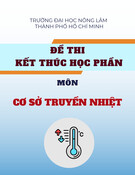
REGULAR ARTICLE
Local correlated sampling Monte Carlo calculations in the TFM
neutronics approach for spatial and point kinetics applications
Axel Laureau
*
, Laurent Buiron, and Bruno Fontaine
CEA, DEN, DER, Cadarache, 13108 Saint-Paul Les Durance Cedex, France
Received: 11 November 2016 / Received in final form: 4 March 2017 / Accepted: 4 April 2017
Abstract. These studies are performed in the general framework of transient coupled calculations with accurate
neutron kinetics models. This kind of application requires a modeling of the influence on the neutronics of the
macroscopic cross-section evolution. Depending on the targeted accuracy, this feedback can be limited to the
reactivity for point kinetics, or can take into account the redistribution of the power in the core for spatial
kinetics. The local correlated sampling technique for Monte Carlo calculation presented in this paper has been
developed for this purpose, i.e. estimating the influence on the neutron transport of a local variation of different
parameters such as sodium density or fuel Doppler effect. This method is associated to an innovative spatial
kinetics model named Transient Fission Matrix, which condenses the time-dependent Monte Carlo neutronic
response in Green functions. Finally, an accurate estimation of the feedback effects on these Green functions
provides an on-the-fly prediction of the flux redistribution in the core, whatever the actual perturbation shape is
during the transient. This approach is also used to estimate local feedback effects for point kinetics resolution.
1 Introduction
The study of power reactor behavior during normal and
abnormal operation raises the incentive of modeling the
transient phases. This kind of application may require multi-
physics tools able to take into account the interaction
between the neutronics that provides the fission power
source and other physics such as the thermal hydraulics that
models the cooling aspects, or mechanics to take into account
the core deformation or the pellet-cladding interaction. Each
component of these interactions implies complex feedback
effects resulting in a strong coupling that requires dedicated
appropriate physical models and numerical resolution to
balance precision and reasonable computation time. In this
frame, some simplifying assumptions in neutron kinetics
modeling have to be made since the increase of computation
capabilities is not yet sufficient for direct time-dependent
Monte Carlo calculations at the full reactor core scale.
Hybrid approaches may be used, like improved quasistatic
methods, but they require regular updates of the power shape
and of the reactivity using precise core calculations.
In this frame, the Transient Fission Matrix (called
TFM) approach developed in [1–3] and presented in
Section 2 is used here. This approach is based on a
conversion to discretized Green functions of the Monte
Carlo response in order to perform kinetic calculations
without new reference calculation during the transient and
thus with a reduced computation time. The TFM approach
requires the development of specific interpolation models to
perform coupled calculations in order to take into account
the evolution of the system’s cross-sections during the
transient. Previous developments [1] provided interpola-
tion models for PWRs and MSFRs (Molten Salt Fast
Reactors), allowing 3D calculations coupled to Computa-
tional Fluid Dynamics to be performed. These models are
restricted to thermal reactors with a small neutron
migration area, or fast reactors without fuel heterogene-
ities. They are not appropriate for fast reactors with a
heterogeneous core and specific developments are required
to improve the interpolation. In this paper, we use a sodium
fast reactor as an example, in which the low void effect
requires a highly discretized geometry with a large sodium
plenum and an axial blanket between two fissile zones [4].
Our main focus is on the description of a correlated
sampling technique associated to Monte Carlo calculations
for the interpolation model used in the spatial TFM
approach. Another element developed here is the point
kinetics local feedback parameter estimation. The feedback
effects considered are the sodium density and the Doppler
effects. Instead of estimating the influence of a macroscopic
cross-section variation with two independent Monte Carlo
calculations, this effect is evaluated using the same neutron
histories, leading to a great improvement of the statistical
convergence. Correlated sampling in Monte Carlo calcu-
lations has been developed previously [5–8] and shows a
* e-mail: axel.laureau@cea.fr
EPJ Nuclear Sci. Technol. 3, 16 (2017)
©A. Laureau et al., published by EDP Sciences, 2017
DOI: 10.1051/epjn/2017011
Nuclear
Sciences
& Technologies
Available online at:
http://www.epj-n.org
This is an Open Access article distributed under the terms of the Creative Commons Attribution License (http://creativecommons.org/licenses/by/4.0),
which permits unrestricted use, distribution, and reproduction in any medium, provided the original work is properly cited.

limitation due to the poor convergence if the perturbation
of the source neutron distribution is too large. Previous
work [9] has shown the usefulness of the fission matrices to
solve this issue on simple systems. The objective of the
present work is to develop a neutronic method that is
suitable for a sodium cooled reactor core and efficient for
time-dependent applications such as transient calculations
through a coupling to thermal hydraulics.
Themethodology presentedherecombinesthecorrelated
sampling technique and the TFM approach. It is based on
a neutron weight modification associated to the origin
(density/Doppler) of the perturbation and to its position
in the core as presented in Section 3. The calculation of
the Green function’s perturbation on a simple test case is
detailed in Section 4 to illustrate the approach.
2 TFM approach
2.1 Introduction of the usual fission matrix
Fission matrices are a tool usually used in Monte Carlo
calculation codes to accelerate the source convergence [10–
13]. This tool is designed to characterize the neutron
propagation in a reactor during one generation: the Green
function is the system response to a neutron pulse. Using a
discretized reactor where the subscripts i,jand krefer
to volumes, the amount of neutrons produced per fission
in volume iinduced by a neutron emitted in volume j
corresponds to the fission matrix Gelement of line iand
column jas shown in Figure 1. The subscript kwill
represent the perturbation position in the next sections.
The Fission Matrices correspond to the discretization of
the Green functions. By construction, the matrix-vector
1
multiplication applied on the generation gsource neutron
vector N
g
corresponds to the propagation of this source
neutron over one generation: Ngþ1¼GNg. The eigen
vector Nof the fission matrix is solution of the equation
GN¼keff N. It corresponds to the equilibrium source
neutron distribution in the reactor and is associated to the
multiplication factor k
eff
as the eigen value.
The fission matrices can be estimated using a Monte
Carlo calculation, associating to each calculated neutron
its emission position jand recording the neutron produc-
tion per fission nS
f
cin each volume i(using the fission
neutron multiplicity n, the total fission macroscopic cross-
section S
f
and the neutron flux c). Because of the local
information of the neutron transport from jto i, even an
estimation using an unconverged source neutron distribu-
tion provides the correct eigen vector and consequently the
converged source distribution. This feature assumes that
the discretization of the fission matrix is fine enough to
catch the source neutron distribution variation. For this
reason, fission matrices can be employed to estimate the
equilibrium source distribution and to improve the source
convergence. If the fission matrix is estimated using a
converged source neutron distribution, there is no
assumption on the mesh precision since the source neutron
distribution inside volume jis the actual distribution.
2.2 TFM presentation
This section presents a general overview of the TFM
approach. More details and a validation of the TFM
approach on nuclear systems such as the Flattop and the
Jezebel experiments can be found in references [1–3]. Note
that the objective of this approach is not to produce a
reference solution such as a direct kinetic Monte Carlo
calculation, but to provide a precise spatial kinetic
modeling with a reasonable computation time. The error
associated to this method can be evaluated by comparison
with full Monte Carlo calculations, on snapshots during a
transient calculation, or with direct kinetic Monte Carlo
when such a code will be available in the future.
Comparisons with direct kinetic Monte Carlo without
thermal feedbacks have already been performed and are
detailed in [1].
In order to perform transient calculations using the
fission matrices, two pieces of information have to be added
to the usual fission matrices: the distinction between
delayed and prompt neutrons and the temporal aspect.
2.2.1 Prompt and delayed neutrons
Delayed (labelled “d”) and prompt (labelled “p”) neutrons
have different emission spectra and consequently distinct
behaviors in the reactor. Moreover, the production of
delayed neutrons is different from that of prompt neutrons
since their multiplicities are not the same. For these
reasons, four different matrices have to be calculated to
take into account each case: Gxpnp,Gxpnd,Gxdnpand Gxdnd.
They correspond to the transport probabilities using the
emission spectrum x
p
or x
d
and the neutron production
multiplicity n
p
or n
d
. These matrix calculations are
performed with a Monte Carlo neutronic code using the
same approach as for the usual fission matrices, the code
being modified to link the origin of their emission (prompt
or delayed) to the transported neutrons and to score
separately n
p
S
f
cand n
d
S
f
cat each interaction. Different
Monte Carlo codes may be used, and the present paper is
based on calculations done with a modified version of the
Serpent2 code [14].
Fig. 1. Neutron propagation over one generation, and repre-
sentation of the fission matrix element ij: neutron production in
volume iinduced by an incoming source neutron emitted in j.
1
All the vectors are represented in bold, whereas the matrices are
represented underlined with two lines.
2 A. Laureau et al.: EPJ Nuclear Sci. Technol. 3, 16 (2017)

2.2.2 Temporal aspect
The second factor required to perform neutron kinetics with
the fission matrices is the temporal aspect of the neutron
propagation. Considering that the neutron transport time
is negligible compared to the delayed neutron precursor
lifetime, only the prompt neutron fission to fission time
matrix Txpnpis needed. This matrix contains the average
propagation time for a source neutron from jto i.
2.2.3 Neutron kinetics equations
As developed in [1–3], this approach allows the estimation
of kinetics parameters and the calculation of neutron
kinetics. An importance map of the reactor is accessible
using the transposed fission matrices (backward trans-
port): the eigen vector solution of this adjoint problem
corresponds to the adjoint neutron source distribution.
This importance map is used in association with the fission
and time matrices to calculate the effective fraction of
delayed neutrons b
eff
and the effective lifetime l
eff
. This
property has been used to validate the approach [3]. The
neuron kinetics equations can be developed using N
p
(t),
the prompt neutron production at time t, and X
f
lfPfðtÞ,
the delayed neutron production induced by the decay of the
precursors.
2
These are balance equations:
dNp
dt¼Gxpnp
1
leff
NpþGxdnpX
f
lfPf1
leff
Np
dPf
dt¼bf
b0
Gxpnd
1
leff
NpþGxdndX
f
lfPf
!
lfPf:ð1Þ
Note that these equations do not use directly the
effective fraction of delayed neutrons. The importance of
the delayed neutrons is taken into account through
the GxdnpX
f
lfPfmatrix that deals with the probability
for a delayed neutron to produce a new prompt neutron, and
the difference between this production and the total prompt
neutron shape is then explicitly modeled. Concerning the
effective lifetime used in 1
leff
Np, this formulation assumes that
the prompt neutron shape is near to the equilibrium, which is
correct in most of the transients studied here. The neutron
lifetime evolution during the transient is correctly taken into
account, but an assumptionis done here considering that this
prompt neutron lifetime is small compared to the transient
characteristic time constant.
2.3 Fission matrix interpolation
During a transient calculation, the reactor composition and
temperature shape can evolve. Thus, the TFMs Gxxnx
and Txpnpmust be estimated in order to integrate the
neutron kinetics equation (1). Different interpolation
models have been developed in previous work [1–3]. These
models are based on the combination of distinct calcu-
lations: a reference case and a case with a global
modification of the system such as the coolant density,
the fuel temperature, the boron composition or the control
rod position in the reactor. All the matrices of the TFM
approach are estimated only once, before the transient
calculation.
Finally, during the transient calculation, these uni-
formly perturbed matrices are used to interpolate the
matrices corresponding to the real state of the reactor and
are used to compute the neutron kinetics. The perturbation
in the reactor is usually not homogeneous; for example, the
reactor may have a complex density distribution. The
interpolated matrix then combines on the fly the local
neutron transport information contained in the different
reference matrices as detailed in this article in Section 4.3.
For a PWR assembly [1], a very good agreement on the
flux redistribution and k
eff
prediction has been obtained on
the control rod up-down movement, from two distinct
calculations (rods in and rods out), all the intermediate
states being successfully interpolated with a reduced
calculation time (around 1/100 s). For 3D coupled
calculations of a Molten Salt Fast Reactor [1,2], a very
good agreement has been obtained with direct Monte
Carlo calculations, using an improved interpolation
scheme based on the absorption localization additionally
to the fissions to take into account the fuel salt density
effect. These two cases show that the TFM approach may
be used for thermal spectrum as well as for fast spectrum
reactors. However, this interpolation scheme is not
appropriate for a sodium density variation in the sodium
plenum: even without absorption, a variation of the
density has a significant impact on the neutron leakage.
For this reason, the local information contained in the
fission matrix is not enough to obtain an appropriate
interpolation model. Instead of “source neutron transfer
probability from volume jto volume i”, the information
required is the “source neutron transfer probability from
volume jto volume i assuming a perturbation in the
crossed volume k”.
3 Monte Carlo and correlated sampling
In Monte Carlo codes, the estimation of the influence of a
local variation of the macroscopic cross-sections can be
performed using two independent calculations with a local
modification of the media. Two drawbacks render this
approach inappropriate here:
–since the variation of the parameters of interest is not
large compared to the statistical error, the estimation
would require a large number of simulated neutrons;
–in order to estimate the effect of hundreds of local
perturbations, hundreds of calculations would be re-
quired and the computation cost would be prohibitive.
A second option consists in using a single calculation to
estimate both the reference and the perturbed config-
urations using the correlated sampling technique. To each
neutron is associated one (or more if several perturbations)
perturbed weight, which is modified at each interaction in
2
“f”standing for the precursor family number.
A. Laureau et al.: EPJ Nuclear Sci. Technol. 3, 16 (2017) 3

order to take into account the medium modification. The
equivalent “perturbed”neutron follows the same series of
interactions as the “unperturbed”one, so that the sampling
is the same, but its weight is modified accordingly. This
evolution of the perturbed weight is a multiplicative
process, all the contributions of all the interactions during
the neutron’s life are staked and used to weight the scores.
Three different materials are associated to each cell of
the geometry in this study: a reference one, one with a
lower coolant (sodium) density, and one with a higher
temperature (Doppler broadening of the cross-sections).
The neutron transport corresponds to the interactions
with the reference material, the perturbed transport being
reconstructed using the perturbed weight attached to the
neutron history w
pert
. Depending on the perturbation of
the interaction probability, the perturbed neutron weight
evolves and is used to score the parameters of interest such
as kpert
eff with the same statistical uncertainty as k
eff
.Inthis
way, a small quantity like the reactivity variation linked
to the local perturbation Drpert ¼1=keff 1=kpert
eff can be
estimated directly, without using the difference of two
numbers with their own statistical error.
Note that this correlated sampling technique assumes
that the nucleus already exists in the core (i.e. control rod
insertion) and that the amplitude of the perturbation is not
too important to avoid large modifications of the neutron
weight. For this reason, perturbations are limited to a few
percents on materials densities and this approach cannot be
directly used for effects such as control rod movement. The
interaction of a neutron with an element that does not exist
in the perturbed version of the reactor will create neutrons
with a perturbed weight equal to zero.
As discussed below, two processes have to be tracked
during the Monte Carlo calculation, viz. the sampling of
the distance between two interactions and the interaction
type (scattering, fission, etc.). Finally, using a perturbed
weight, the effect of a local modification of the materials
can be taken into account in the fission matrices.
3.1 Next interaction distance sampling
For a given neutron energy, the distance between two
interactions is sampled using the normalized density
distribution: Stot expðd·StotÞwhere S
tot
is the total
cross-section at the neutron energy and dthe interaction
position. The perturbed distance is calculated using the
perturbed macroscopic total cross-section Spert
tot instead of
S
tot
. Thus, since the perturbed transport is based on that of
the reference (i.e. uses the same reference sampled distance
d), the perturbed neutron weight is multiplied by the
ratio of the probability of reaching this position:
Spert
tot expðd·Spert
tot Þ
Stot expðd·StotÞ:ð2Þ
For example, if Stot <Spert
tot , the neutron averaged
sampled distance is smaller in the perturbed system. For
this reason, if the sampled distance tends towards 0, the
neutron perturbed weight will increase by Spert
tot
Stot >1. In this
way, the future interactions (scattering, fission, etc.) of the
neutron will be scored with an increased weight due to the
contribution of this “transport event”, and the weighted
neutron is representative of the perturbed system.
3.2 Interaction type sampling
Once the position of the interaction is sampled using the
total cross-section, the nucleus and the interaction type are
also sampled (fission, absorption, elastic and inelastic
scattering, etc.).
Assuming a sampled reaction ron nucleus n, the
probability of this reaction among all the possible reactions
is Sn;r
Stot. The probability of the same reaction on the same
nucleus with the perturbed material is Spert
n;r
Spert
tot
. Finally, the
neutron perturbed weight is multiplied by:
Spert
n;r·Stot
Spert
tot ·Sn;r
:ð3Þ
3.3 Perturbed neutron source
The Monte Carlo calculation works with batches of
neutrons corresponding to different generations with a
source distribution given by the fission position of the
previous batch. The neutron source distribution in the
perturbed reactor is different from the reference distribu-
tion. The difference between those distributions is taken
into account by the perturbed weight of the neutron at its
creation, but this weight is not initially known. The initial
neutron weight is preset with the perturbed weight of its
father, i.e. the neutron that has produced the fission. An
issue with that technique is the progressive increase of the
perturbed weight dispersion. Each neutron has an
independent life in the reactor; then if there is no clustering
(as expected) of the neutrons, they will not mix their
perturbed weights and some of the neutrons will have a
prohibitive weight. These neutrons will make the contri-
bution of the other neutrons negligible. For this reason, the
number of generations used to propagate the source
neutron weight is limited according to a sensitivity study
done for each application case.
For the TFM application, the perturbed source
distribution is not required. As already explained, if the
mesh used for the fission matrices is fine enough to model
the flux redistribution, the eigen vector will be correct since
the information contained in the fission matrix is the local
propagation of the neutrons. For this reason, the results
presented here use a perturbed weight initialized to 1 and
do not propagate the perturbed weight of the ancestors.
4 Correlated sampling application to TFM
4.1 Application case description
In order to illustrate the estimated matrices, a simple one-
dimensional case derived from as SFR assembly with only
three areas (fissile, sodium and B
4
C) has been considered in
this paper and is represented in Figure 2. This simplified
case is also used in [15], together with a more complex case
4 A. Laureau et al.: EPJ Nuclear Sci. Technol. 3, 16 (2017)

representative of an ASTRID [16] assembly, for a
validation of this approach based on comparisons with
direct Monte Carlo and ERANOS calculations. Note that
the fuel region here corresponds to an assembly homoge-
neisation so that it contains fuel, sodium and steel. The
geometry boundary condition is a radial reflexion and an
axial leakage.
The material temperatures and isotopic reference
compositions are given in Table 1. These compositions
are considered radially homogeneous so that, for example,
the B
4
C area contains sodium and steel.
4.2 Global fission matrix interpolation
Using the correlated sampling approach, we have obtained
scores corresponding to different perturbed states of the
reactor. Typically, in order to run transient coupled
calculations, the perturbations of interest concern the
coolant density and the fuel temperature. Using a
perturbed weight for each neutron, it is thus possible to
generate the variation of the fission matrices for each
element i,jaccording to a global modification of the sodium
density and of the temperature in a sodium cooled fast
reactor. This is stored respectively in the variation
matrices
~Gden
xxnxand ~Gdop
xxnx. Even if the matrices of interest
for neutronic calculations are the fission matrices, these
variation matrices will be very useful to interpret the effect
of a perturbation on the core.
In the following, a density dependency with a variation
of 1% and a temperature dependency with a variation of
+300 K (representative of the order of magnitude of the
expected variation during transients) are estimated in this
way. Based on the information contained in these two
variation matrices, any other global perturbation can be
interpolated using a linear dependency on the sodium
density Dr
sodium
, and a logarithmic dependence on the fuel
temperature T
mean
using equation (4).
GxxnxðDrsodiumÞ¼Gxxnx~Gden
xxnx·Drsodium
GxxnxðTmeanÞ¼Gxxnxþ~Gdop
xxnx
logðTmean=Tref Þ
logððTref þ300Þ=Tref Þ:ð4Þ
Figure 3 presents the reference fission matrix Gxpnp
(left) and its variation with the density (middle) and the
Doppler effects (right). The neutron propagation is directly
visible on this fission matrix (left). Each emission position
corresponds to a column, and for this column, the position of
the neutrons produced by fissions corresponds to the different
lines. We can see that all the fissions come from and occur in
the fissile zone with an index between 0 and 30. The
probability of generating a new source neutron is reduced close
to the small values of index jand idue to the leakage at the
bottom of the assembly. On the contrary, around bin 30, the
sodium is a neutron reflector so that the source neutron
production is less impacted by the end of the fuel area.
Concerning the density effect (middle), the neutron
production is reduced on the diagonal of the matrix (for a
target volume iclose to the origin volume j), and the
production is relocated far from the neutron emission
position. This effect is due to a larger mean free path
resulting from the decreased sodium density. Near the
boundary between the fuel area and the sodium, the strong
negative feedback is explained by more neutron leakage to
the B
4
C.
Concerning the Doppler effect (right panel), the impact
on the neutron propagation is not a relocalisation such as
with the density change, but a negative global feedback due
to a modification of the fission-absorption ratio and
spectrum. The effect is larger near the sodium area.
4.3 Local fission matrix interpolation
In usual applications implying a coupling with other
physics like thermal hydraulics, a global perturbation is not
enough to model the complex variations on the tempera-
ture distribution in the core. The local feedback effect has
to be estimated using local perturbed weights.
Fig. 3. Fission matrix Gxpnp(left) together with its variation due
to a sodium density decrease of 1% (middle) and a temperature
increase of +300 K (right).
Fig. 2. Simple case geometry description in cm.
Table 1. Material temperatures and compositions –10
24
atoms per cm
3
.
Fiss –1500 K Na –600 K B
4
C–600 K
16
O 1.952e02
23
Na 2.106e02
10
B 6.388e03
23
Na 6.352e03
11
B 2.587e02
56
Fe 1.861e02
12
C 8.065e03
235
U 1.542e05
23
Na 1.094e02
238
U 7.599e03
56
Fe 1.256e02
238
Pu 5.833e05
239
Pu 1.238e03
240
Pu 5.773e04
241
Pu 1.617e04
242
Pu 1.743e04
241
Am 2.713e05
A. Laureau et al.: EPJ Nuclear Sci. Technol. 3, 16 (2017) 5









![Ngân hàng trắc nghiệm Kỹ thuật lạnh ứng dụng: Đề cương [chuẩn nhất]](https://cdn.tailieu.vn/images/document/thumbnail/2025/20251007/kimphuong1001/135x160/25391759827353.jpg)






